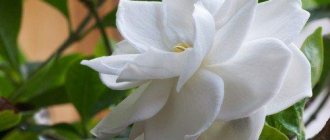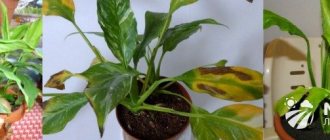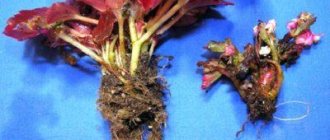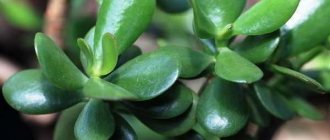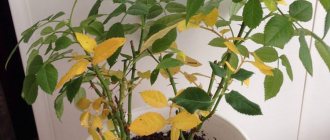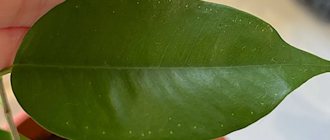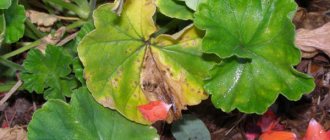Croton or codiaum is a magnificent indoor plant, of the Euphorbiaceae family, with very beautiful, bright leaves. In nature, it is found only in Southeast Asia, where it can reach about 4 meters in height. At home, croton grows no higher than 60-70 cm. Its characteristic feature is thick, fleshy leaves of different shapes and colors. The color can vary from greenish-yellow to orange-red, and even black, and the shape can be straight, lanceolate, with wavy or smooth edges, spade-shaped, twisted, etc.
Croton - a house flower with unusual foliage
Reasons why croton leaves dry and fall off
Croton is considered one of the most capricious and demanding plant conditions. The juice released when the stems of the plant are damaged is extremely poisonous, so when caring for croton you must be extremely careful and wear rubber gloves. Not recommended for families with small children and pets .
Growing it at home is not at all easy, but it is possible. The main thing is to monitor the appearance of the leaves. If they begin to turn yellow and fall off, there may be many reasons for this.
The main ones are:
- violation of temperature and light conditions;
- improper watering;
- damage by diseases and pests;
- insufficient humidity in the room;
- adaptation after transplantation.
Such symptoms often appear immediately when purchasing a plant. It is very difficult for Croton to get used to new conditions, but if all the necessary criteria are met, then after a couple of weeks the leaves will stop turning yellow and falling off. What to do when a plant starts to hurt, and how to properly care for it?
Watering
The cause of foliage loss may be a violation of the watering regime.
The cause of yellowing and loss of foliage in croton can be insufficient or excessive watering. It is important to ensure that the soil in the pot is always moderately moist.
Water the plant with warm (settled), soft water. Once every 2 weeks, the croton is given a generous shower, and the leaves are regularly sprayed. To prevent the soil from being washed away during this procedure, it is recommended to cover the pot with film. In summer, you will have to water the flower every 2-3 days, and in winter – once every 5 days.
Temperature
An equally important parameter for the normal growth and development of croton is the correct air temperature. It should not fall below +16, although such a temperature is already dangerous. Rooting of the root system and death of the plant may begin.
The ideal temperature in summer is between +23+25, no lower or higher, and in winter – up to +20. Croton does not tolerate sudden changes and temperature fluctuations. Any drafts are very dangerous for him.
Air humidity
Insufficient humidity causes yellowing and falling leaves
Croton grows well only in a room with high humidity, so it is recommended to place it on a special tray with moistened moss or expanded clay. A small amount of water is regularly added to the container, which, evaporating, creates the necessary conditions for plant growth.
Some experts advise not only spraying, but also gently wiping the croton leaves with a damp sponge or napkin. This will clear them of dust and dirt and humidify the air around them. Throughout the heating season, you can use electronic humidifiers. A dry indoor climate contributes to the development of many diseases and the appearance of spider mites.
Lack of microelements
Croton leaves often dry out and fall off due to a lack of nutrients in the soil. Timely fertilizing or transplanting into fresh soil can help.
To prevent yellowing of the leaves, it is necessary to regularly apply complex mineral fertilizers. In the period from April to November, the plant is fertilized twice a month, and in winter - once a month. Before applying fertilizers, the soil is well moistened, and minerals must be dissolved in water, according to the instructions.
Incorrect placement location
Croton should not be placed in close proximity to heating appliances
Croton does not grow well near window glass or next to heating appliances. Temperature changes are detrimental to the plant. The optimal place for it is wide window sills on the western or eastern side of the apartment.
It is important to ensure that there are no even short-term drafts, and to protect your exotic pet from direct sunlight . If there are no other reasons for the disease and loss of leaves, then you will have to change the location of the plant.
Failure to comply with lighting conditions
Croton feels best in diffused light. Direct sunlight is harmful to it. If the plant has not been under the scorching sun for long and has received a burn, then it is still possible to help it. It is enough just to move it to partial shade.
Watering
The soil in the pot should always be slightly moist. In summer you have to take a watering can every 2-3 days. Croton loves moist soil. In this case, not only the top layer should be wet, but the entire lump, to the bottom. Codiaum has a developed root system that goes deep into the ground. If the roots do not have enough water, this will immediately be noticeable in the appearance of the plant: the leaves will begin to dry out. A prolonged lack of water becomes the reason why croton leaves fall off.
Excess water is no less dangerous. Typically, the danger of “flooding” a plant occurs in winter. At this time, the need for water decreases in almost all crops, as they enter a dormant period: the growth rate decreases, flowering and fruiting stop. However, the owners continue to water in the same volumes as in the summer. If there is excess moisture, the roots rot, which causes the death of the plant. Therefore, in winter they water twice as often: once every 4-6 days.
In order not to “flood” the codiaum, it is necessary to drain excess water from the cup standing under the pot. A thick layer of drainage is poured onto the bottom. This will prevent root rot. When the air temperature in the room decreases, the intensity of watering must be reduced.
Diseases and pests
The cause of falling and yellowing of leaves is fungal diseases (anthracnose, root rot) or pest attack (scale insects, spider mites). How to save an affected plant without causing harm to it?
The first sign that a mite has settled on the leaves is the presence of a white coating on them. The reason for this is insufficient watering. With normal moisture, the poisonous sap secreted by the plant serves as excellent protection against pests. Dry, diseased leaves cannot repel ticks.
To get rid of it, it is enough to treat croton three times with any insecticide for indoor plants (Aktellik, Fitoverm, Akarin), with an interval of a week. Some gardeners recommend wiping the leaves and stems of the plant with a soap solution or tobacco infusion, preventing it from getting on the soil. After 50-60 minutes, the plant is carefully rinsed in the shower.
Croton can be attacked by scale insects
The scale insect rarely affects croton, and it appears in the form of small brown spots. They can be carefully removed using a cotton swab dipped in a soap-vodka solution (2 tablespoons of vodka/liter of water and a little soap). After 2-3 hours, the solution must be washed off. As a rule, one treatment is enough to completely get rid of pests.
Excessive watering and high humidity lead to the appearance of anthracnose on the leaves. The plant can only be cured by treating it with fungicides. The procedure is carried out at least 3-4 times every 10 days.
Excessive humidity is also dangerous due to rotting of the root system, which also manifests itself in the form of yellowing and falling leaves. This condition most often occurs in recently purchased young plants. Replanting in nutritious soil from leaf and turf soil with the addition of peat, humus, sand and charcoal, taken in equal parts, can help. A layer of drainage must be placed at the bottom of the pot.
Newly acquired plants are replanted only after acclimatization.
Replanting is carried out by transshipment (every spring), and damaged roots are carefully removed (without destroying the earthen ball). Old plants cannot be replanted often. One transplant every three years is enough.
Description of Croton, or Codium
Croton flower photo and how to care photo
Croton in indoor conditions is a bush. Its leathery leaves are varied in shape: asymmetrical, oblong-lanceolate, pointed or with a blunt end, entire, three-lobed, notched, broadly ovate, etc.
Young leaves have a light yellow-green tint, and with age they become more saturated green and burgundy, so that croton looks like an elegant autumn tree. All varieties and varieties of the plant have pronounced veining on the leaves.
How croton blooms
How croton blooms photo
Flowering croton - inconspicuous cream flowers, collected in an axillary pendulous raceme inflorescence, the flowering does not cause much delight.
Dangerous and spectacular
House croton is considered one of the most capricious plants. Consider these care features:
- All work with croton must be carried out strictly with gloves, because its juice is poisonous and causes contact dermatitis, vomiting, and diarrhea.
- At home, croton needs not just to spray the leaves, but to wipe them with a damp soft cloth or sponge. In summer, it is recommended to take a warm shower every month.
- The plant categorically does not tolerate drafts and watering with cold water.
- At the beginning of the growing season, sometimes croton leaves can take on the most bizarre shapes. This is most likely due to its high mutation capacity. Thanks to such amazing variability, many varieties and hybrids of croton are developed, which differ only in the shape of the leaves.
- It is recommended to remove peduncles and flower buds immediately, because they do not bring aesthetic pleasure and take a lot of energy from the plant.
Tips and tricks for caring for croton
Croton is a very capricious plant to care for.
Caring for croton is not an easy task. It is necessary to strictly observe the temperature regime, monitor watering and humidity, and provide good, moderate lighting. In the summer-spring period, much attention is paid to fertilizing, spraying and watering. In winter, you will need additional lighting, reduced watering and a lower temperature in the room. If you follow these rules, growing croton will not cause much trouble.
The tips of the leaves dry out
Why do the tips of croton leaves dry out?
Most often the reason for this is too low air temperature .
What temperature conditions are suitable for codiaum? The normal temperature for growing this plant is +14…+20 degrees.
In order for croton to grow and develop well, it is necessary to provide it with a balance of moisture and heat , because insufficient watering can also be the reason why croton leaves dry out.
Croton is losing its leaves
look also here. or -
Codiaeum variegata, or also called croton, has always been a very rare, prestigious and very expensive houseplant. You understand this when you see a beautiful tree-like bush, dressed in a luxurious outfit of fancy leaves. The crown of upper veins, light in tone and filled with bright gold, seems to glow from within. The lower and more mature the croton leaves are, the darker they are, up to a noble burgundy, and also seem to be painted with gold.
Among the varieties of croton (variegated codiaum), there are forms with broad-lobed leaves, others with forked and ribbon-shaped leaves, and some have leaves dissected with brightly colored veins.
Croton has its own peculiarity - at a young age, yellow and various shades of green tones predominate on its leaves; with age, pink and red spots and stripes appear.
Croton propagates by stem cuttings, which are rooted in water. Rooting takes a very long time - 1.5-2 months. Cuttings should be kept at a temperature not lower than +23-25°C. The rooting container should be opaque. It is advisable to cover the cuttings with a bag to increase air humidity.
It is often said that caring for croton is difficult, and the plant itself is extremely capricious, but this can be said about other house flowers too, because every flower needs careful care and attention. What does Croton need to please us with its splendor? To ensure croton growth, it must be replanted annually in new fertile soil and systematically fed during the period of active growth.
Croton achieves its greatest beauty only in good light - but with a lack of light, the leaves lose their color intensity. In summer, it is better to shade the croton from the sun during the hottest hours, and the most ideal place for this house plant is an eastern or western window.
The substrate should neither dry out nor become waterlogged. In summer, croton requires a lot of water; in winter, watering should be reduced: the soil should dry out between waterings. Excess water, at any time of the year, leads to various diseases.
Croton does not tolerate the dryness of the earthen clod well, and the plant can shed almost all its leaves. Does not tolerate watering with cold water and drafts. Croton should be watered with warm, settled water. The temperature should be constant throughout the year, but not lower than 16°C. With sharp temperature fluctuations and drafts, croton sheds its leaves.
If the lower leaves of the croton fall off, to slow down this process, start spraying the plant - croton loves moist air. So croton needs to be regularly sprayed and wiped with leaves.
Young plants are replanted annually in March-April, old plants - after 1-2 years. For replanting, take an earthen mixture of 2 parts leaf soil, 1 part turf soil, 1 part river sand and pieces of charcoal.
Most often, croton is affected by scale insects (the leaves lose color, dry out and fall off). Dry indoor air promotes red spider mite infestation (solid whitish spots form on the surface of damaged leaves, leaves fall off prematurely).
For good growth, croton needs a light place (so that the leaves do not turn pale), but without direct sunlight, warmth, sufficient watering, spraying and maintaining high air humidity. Young leaves may fall off from:
— drying out of the soil (there should be abundant watering in summer and moderate watering in winter; after watering, excess water must be removed from the pan);
- lack of nutrition in the soil (2 weeks after purchasing an imported croton with poor peat soil in a pot, it must be transplanted into nutritious soil consisting of turf, leaf, humus soil, peat and sand in equal parts with the addition of pieces of charcoal in a slightly larger a pot with good drainage; then replant young actively growing crotons every 2 years, and old ones only when necessary);
- lack of fertilizer (from March to August, apply a little fertilizer every week).
Perhaps moved to a darker place? Or is it too dry? Overflow is less likely; the flower loves water, but this cannot be ruled out. Loosen the soil deeper and carefully. Air access to roots. If only 1-2 leaves fall off, this is normal. If there is leaf fall, there is something wrong with the roots. They dried up, suffocated, froze.
By dropping leaves, croton, or codiaum, reacts primarily to cold and drafts. Check if your plant is in a draft. High air humidity on a rainy day, on the contrary, is very favorable, however, due to lack of lighting, the bright color of the leaves fades, and sometimes they even lose color and turn green. When caring for croton, it is very important to prevent the roots from overcooling. Therefore, if the windowsill is cold, it is better to place the pot on a wooden stand.
Indoor plant species and varieties
A single species, Codiaum variegatum, as well as its varieties and hybrid varieties, began to be grown as indoor plants. But they represent such a wealth of shapes and colors that other types were simply not useful.
Varieties of Codiaum variegatum:
- The narrow-leaved croton is equipped with long (about 20 cm) leaves, their width is no more than 1 cm. Yellow-golden strokes and specks are scattered across the green background.
- The appendage-like croton is variegated and green. Its leaves, wide at the base, narrow in the middle into a kind of petiole, and then expand again, forming a small leaf appendage at the end.
- Curly codiaum (crispum) has long, narrow, curled leaves. The greenery has stripes, spots, veins or a network of different shades of yellow. The brightest representative of the variety is Spiral with uniform turns of leaves.
- Lobed croton is distinguished by wide leaves divided into three parts. The central lobe is much longer and wider than the lateral ones. Yellow veins decorate the bright green of the leaf.
- Flat-leaved (platyphyllum) codiaum is a plant with large (up to 30 cm in length and 10 cm in width), oval leaves, their edges are slightly wavy.
- Oval-leaved (ovalifolium) with simple leaf blades in the shape of an elongated oval with a rounded end, rich yellow markings located along the veins.
- The tortoiseshell variety (tortile) is distinguished by leaves that are broad at the petiole and taper towards the tip. On an olive green background there are red and yellow stripes along the central vein and chaotic golden spots.
- Genuinum is a variety with solid oval leaves covered with a pattern of silver or gold color with a reddish tint. There are forms with small and ribbon foliage.
- Codiaeum variegatum pictum is the original form for most hybrid varieties. This is a shrub with a straight stem (up to 1 meter in height), which is covered with dense and hard leaves. They are painted with a pattern of bright yellow, red, pink spots on a green field.
The most famous varieties and hybrids of Codiaum variegatum pictum:
- Croton Petra is a branching stem bearing large, leathery leaves. Yellow veins, edges and dots are drawn on the main green background. The shape of the leaves is varied.
- Mrs. Iceton is a variety with wide, rounded leaves. Young plants have a cream pattern on them. With age, the color becomes more intense, becoming pink, yellow or red. There are forms of blood red or very bright yellow shades.
- The Excelent variety is easily recognized by its leaves, similar in shape to oak leaves. Young leaves, at the top of the plant, are yellow-green. At the base of the trunk - burgundy.
- Coroton Mammi is distinguished by narrow, small leaves. Their edges are slightly curved from the center. The color combines different shades of green, yellow, red and pink.
- The Zanzibar variety has long (about 40 cm) yellow-green leaves. They curve gracefully.
- Nervia is a variety with a colorful crown of bright green, lemon yellow and soft pink leaves. They are jagged with a well-defined vein in the center.
- Croton Tamara is a very rare variety. Oval leaves of medium size, bicolor. On the main dark green background, there are light green and white spots closer to the edges.
- Disraeli is a variety with lobed leaves. They are green-yellow above and red brick-colored below.
- Codium Black Prince with flat and wide foliage. The coloring is very original: the background is dark green, almost black, with red, yellow or orange markings.
What is Croton variegatum mix
Often, specialized stores offer plants called codiaum (or croton) variegatum mix. This is not a variety, but an indication that the batch contains specimens of this variety. Their color depends on the conditions and age of the leaves. So the same plant can look different. And even experts sometimes find it difficult to accurately identify the varietal identity of croton.
The name “Croton variegatum mix” can hide any variety
Why do croton leaves dry and fall off and what to do about it?
Croton (Codium) grows in tropical forests. At home, it is demanding of care, since it requires an appropriate microclimate. Below we will consider the main reasons that lead to a plant shedding its leaves.
Improper watering
One of the reasons that causes the leaf blades of codiaum to turn yellow and fall off may be excessive or insufficient amount of water for irrigation. In these circumstances, to save the plant, it is necessary to ensure that the soil in the flower pot is moderately moist.
Violation of containment conditions
The problem may lie in non-compliance with the necessary maintenance conditions for codiaum, such as incorrect temperature conditions and dry air in the house.
Deficiency of any substances
Another reason why the tips of croton leaf blades dry out. Over time, nutrients are removed from the soil. If the flower does not have enough of them, it will begin to wither. At the same time, the leaves can dry out in different ways: appear in spots, like a small rash or large lesions, evenly turn yellow or just start to emerge from the edges, become thin and brittle, like parchment. It depends on what elements the plant lacks. If all conditions meet the requirements of croton, then it is likely that the problem lies precisely in a deficiency of some substances; fertilizing or replanting in fresh soil is required.
Useful tips for growing croton
In order for the codiaum to grow healthy, certain conditions must be met:
- the right pot. The growth of a flower is directly related to the state of its root system, so the pot must be chosen with special attention. It should be wide and not very deep. If you take a pot that is too wide, water for irrigation will accumulate at the roots, which will cause rotting of the root system. You need to take a stable and practical pot. It is better not to use a clay pot - it is heavy and can create some inconvenience for the codiaum. The best option for codiaum is a plastic pot;
- transfer. For young plants, this procedure should be carried out annually; for older plants, it is permissible to do this every other year. The optimal time of year for transplantation is early spring. Croton needs to be replanted in fertile soil, which includes charcoal, river sand, leaf and turf soil. When replanting, the size of the pot should be several centimeters larger than the previous one;
- pinching and trimming. To make croton look neat, young plants are pinched, and adults are pruned. The first pinching is done after the codiaum reaches a height of 15 cm, subsequent pinchings are done every time the stems grow 20 cm. When pruning an adult codiaum, the cut sites are treated with charcoal;
- bloom. Croton flowers do not have decorative value, but flowering takes a lot of energy from the bush. If there is no need to collect seeds, flower buds or peduncles should be removed immediately after they form.
Itching and cancer
Carcinomas of the lung, stomach, colon, prostate, breast, or pancreas are very rarely associated with generalized pruritus. But itching is an important symptom of various mastocytes (solitary mastocytoma, urticaria pigmentosa, macular telangiectasia, systemic mastocytosis).
In human skin, tryptase predominates in mast cells, and chymase predominates in the alveoli and cells of the mucous membrane of the gastrointestinal tract, stomach and intestines. This distinction may help distinguish cutaneous mastocytosis from the systemic form.
The itching of carcinogenic syndrome is sometimes accompanied by redness. Itching is caused by serotonin, which is produced by enterochromafila tumor cells. The symptom decreases with treatment with antiserotonin drugs.
Some authors point to a general connection between itchy skin and brain tumors. However, the relationship between itchy skin and tumors is not always clear. Itching may be the result of an immune mechanism, toxic metabolites, iron deficiency, or dry skin. Removing the tumor may reduce or eliminate the itching. In this case, antihistamines are ineffective.
Prevention measures
The main preventive measure to avoid the problem of fallen leaves in croton is to follow the rules of caring for it, the main points of which are:
- suitable indoor air humidity;
- a warm place with good lighting;
- insulation from direct sunlight;
- proper watering, in which the soil is always moist;
- insulation from drafts;
- timely feeding;
- avoiding sudden temperature changes;
- Regular inspection for diseases and pests.
When croton leaves fall, the first step is to identify the exact cause of this problem in order to take the right steps to eliminate it. Knowing how to properly care for this plant and following preventive measures, you can grow a healthy flower that will delight you with its beauty.
And a few more words about leaving
In addition to what has already been said, the fertility of the soil in the pot is no less significant. Codiaum experiences a particularly acute shortage of nutrients in the summer. As for the composition, it is better to take special complexes for exotic crops. Croton transplantation is possible only once a year. But if the flower has grown a lot, then you can do it twice. But an adult plant is moved only when necessary.
Another important aspect of flower care is propagation. Cuttings are used for this. But to root the little “croton” you need to use heating and phytohormones. Although some gardeners immediately insert the leaf into a special pot and cover it with a glass jar.
Please note that codiaum should not be allowed to bloom indoors. Small light flowers collected in a brush will weaken the health of a green pet, drawing out all the vitamins and microelements from it.
Prevention
In order not to look for drugs for treatment, you need to find a suitable place for croton before purchasing and carefully study how to care for it at home. During the acclimatization period, you should not touch the codiaum, but after that it is even necessary. At this moment, it will be very timely to plant it in suitable soil: a 1:1:1 mixture - turf and leaf soil, with drainage at the bottom of the pot.
What to do if croton leaves fall off?
Croton has long and rightfully won the hearts of flower growers. This is an amazingly beautiful plant with a bright, unusual color of leaves, which reaches a meter in height in a few years. In addition, this flower is very unpretentious. Probably the only problem that its owners face is yellowing and dropping of leaves.
Frequently Asked Questions: Croton
1. I was given a croton, I don’t know what to do with it, what its habits are.
Answer:
It is advisable to transplant Croton into special soil. It's called "Codiaeum". Or ask the soil most suitable for it at a flower shop. Good watering so that the soil does not dry out too much. Bright enough light to variegate the leaves (but not direct sunlight), spray every day, and wash once a week in a lukewarm shower. Croton loves warmth and humid air, so it is advisable to buy another tray, put drainage in it and pour water, it is important that there is no water at the roots. The pot should be spacious enough, but not too big. Croton's roots are quite powerful, but when replanting, it is still advisable to look at the condition of the root system and earthen coma, because It is customary to increase the container slightly, so that there is no more than 3-4 cm between the old lump and the walls of the pot. Well, there is no need to bury it, make good drainage. Croton-karizulka! Whatever is wrong, the leaves are down and there is mortal resentment towards the owner. “. Give me a drink, I’m cold, I’m hot, it’s blowing and shining, and in general you don’t love me. “This is not a complete list of his grievances. Give him a real resort. Everything should be normal, including humidity and watering, indirect sun, washing the leaves, and of course love and markets with it during the procedures.
2. Variegated croton throws out new leaves, but does not want to change their color.
Answer:
If he began to throw out green leaves with the onset of autumn, then he clearly does not have enough light.
3. My croton is dropping its leaves. Almost the entire stem has already been exposed - except for the top.
Answer:
Check the plant for spider mites. Very often, crotons shed their leaves precisely because of this pest (subject, of course, to observing temperature and watering conditions). In addition, if this is the first winter for your croton, then it is not surprising that it sheds its leaves. He didn’t have time to adapt, he’s feeling bad, there’s not enough light and humidity. He should be under the lamp and closer to the sink. If it is on a windowsill, then the problem is the temperature; croton does not tolerate overcooling of the roots and the slightest drafts. It is not worth cutting the top, because croton is not easy to root at all; in the middle of winter it is almost impossible.
4. My Croton's lower leaves fell off and it looked like a “palm tree”.
Answer:
Place it under the lamp on a tray with wet expanded clay. You can’t do anything with a bare stick, but the remaining leaves can still be saved. While the plant adapts, it may shed a few more leaves. In the summer, the croton will grow and the bare trunk will not be so conspicuous. If it does not branch, you can pinch the crown at the end of February - beginning of March.
5. What is the best way to root the top of the croton - in water or in the ground. And what conditions should be created (is bottom heating and lighting necessary?). And is it necessary to keep it in Epin?
Answer:
Method 1: wash the cut, dip it in root, place it in water on the radiator, carefully wrap it in a plastic bag. Ventilate once every 2 days, then spray the leaves with water and return them to the bag on the battery. Method 2: just keep it in water until it gives roots. You just need the cutting to be lignified.
6. I replanted the croton, but after a while it hung all its leaves. What to do.
Answer:
Place it under the bag - the leaves will “stand up” again. You just don’t need to fill it, it’s just a reaction to replanting - perhaps the roots were washed or part of them was damaged. After a week, remove the bag and spray it more often at first. Although it is better to handle such capricious plants as croton without disturbing the earthen coma and spray it with epin 2 times. Otherwise it might even shed its leaves. And once he comes back to life, gradually accustom him to life without the package.
7. Rooting a croton leaf.
Answer:
This is, in principle, possible - if you need a croton leaf with roots. It will never become a tree; it is necessary to root a leaf with a cutting and a bud.
Causes of yellowing leaves
The croton's homeland is considered to be Oceania and the countries of Southeast Asia, where it grows in tropical forests, which is why maintaining comfortable living conditions with warm air and high humidity is very important for domestic crotons. This plant requires moderate watering, regular replanting and fertilized substrate. The flower is demanding on lighting; it does not tolerate any drafts.
Any unfavorable change in the habitat immediately causes a negative reaction in croton - it begins to turn yellow and shed its leaves. However, in the vast majority of cases, a green pet can be saved if timely measures are taken to resuscitate and restore it.
Watering
Most often, croton sheds its leaves due to a violation of the irrigation regime. Like most tropical exotics, it prefers moist air and good irrigation, which is why it is important to carefully monitor the condition of the soil - it must be constantly moist. This is true both in summer, when the weather is hot outside, and in winter, when heating is on in residential areas.
Croton propagation by cuttings
Croton cuttings how to root photo
For vegetative propagation, apical cuttings 6-10 cm long are used. If you want to get several cuttings, you can open the shoot into pieces so that each segment contains one internode with one healthy leaf. Semi-lignified and woody cuttings take root best.
The poisonous milky juice flowing from the slices must be washed off with water and the slices allowed to dry for three hours in the air. Then treat the cut with root (growth stimulant) and place the cutting in water and heat it to a temperature of 23-30 ºC (so that the planting material does not rot).
Lighting needs to be bright and diffused. When roots about 2 cm long appear on the cutting, transplant it into a substrate for codiaum (croton). During the first 15 days after transplantation, it is necessary to spray the plant frequently to create increased humidity. When the leaf regains its elasticity, it means the cutting has begun.
Diseases and pests
The reason crotons turn yellow and drop their leaves is often a plant disease or an attack by insect pests.
Of the diseases, culture most often faces the following problems.
- Anthracnose - in this case, reddish and ash-gray spots of arbitrary shape form on the leaves, and soon after their appearance the leaves begin to fall off.
The diseased plant must be isolated, then transplanted into a new substrate and a new pot, and then sprayed with special preparations. “Cumulus”, “Fundazol” and “Euparen” are characterized by maximum efficiency.
- Root rot - yellowing and pallor of leaves is considered the very first sign indicating such a disease. If you dig up a plant, you will notice that the roots have begun to rot - this happens due to low acidity of the soil.
To revive your green pet, you should cut off all the affected areas, replant the plant in nutrient soil and water the fungicides “Fitosporin” or “Alirin-B” at the root.
Of the pests, the following parasites cause the greatest harm to croton.
- The spider mite is a very small spider, which is quite difficult to detect with the naked eye, but its appearance can be judged by the thin gray-silver webs on the back of the leaf. The parasite sucks out the vital juices of the plant, which leads to its withering. To get rid of the mite, you need to wash the leaf blades and young green stems with shag infusion with the addition of laundry soap or treat them with special insecticides.
- Scale insect - this insect can be identified by characteristic plaques on the inside of leaves and stems. The danger of scale insects is that they multiply very quickly and can destroy even a large plant in the shortest possible time. You can save the flower by washing it with tobacco infusion or soap solution.
Insolation
Lighting mode plays a big role. In direct sunlight, croton also drops its leaves. If this behavior is noticed, it is necessary to move the flower to another place, more shady and cooler. If exposure to sunlight was short-lived, the crop will quickly recover: the leaves will rise again, become elastic and strong. If the codiaum has stood under the scorching rays for a long time, then the process becomes irreversible; the plant will only have to shed the burnt foliage. Due to regular excess sun, an indoor flower may die.



